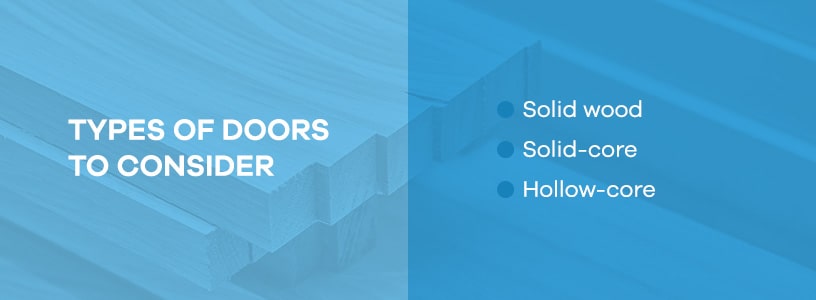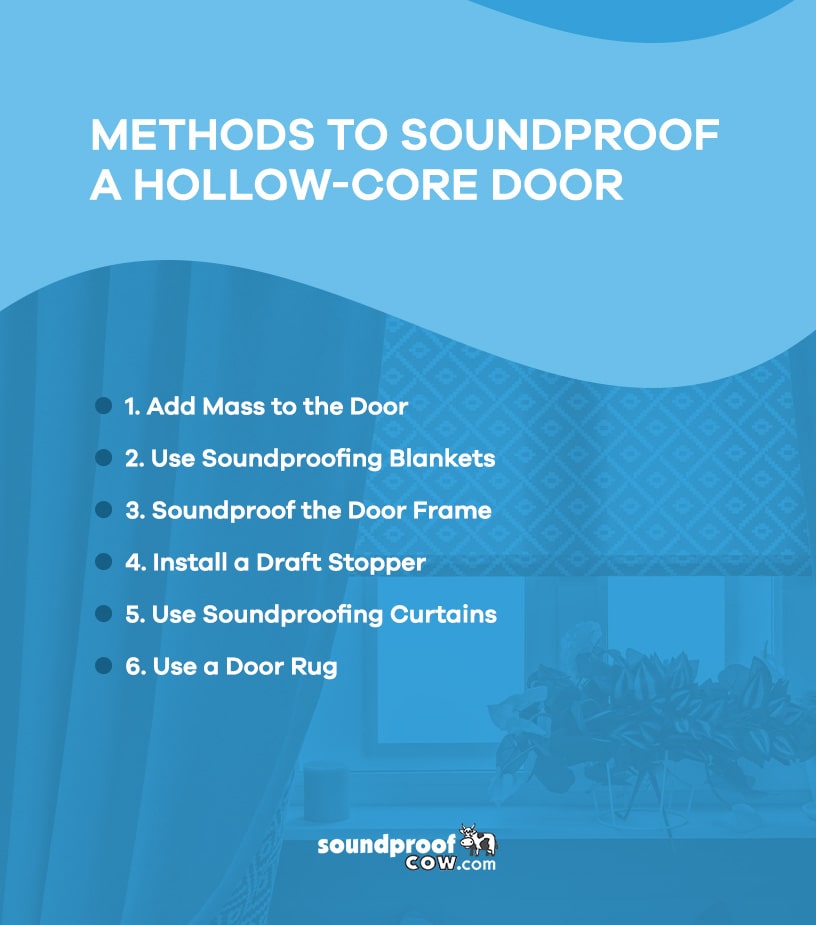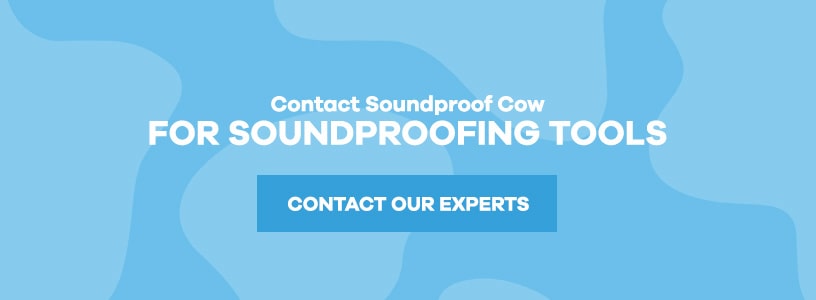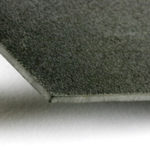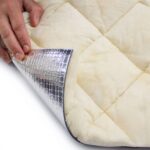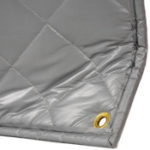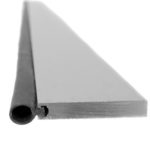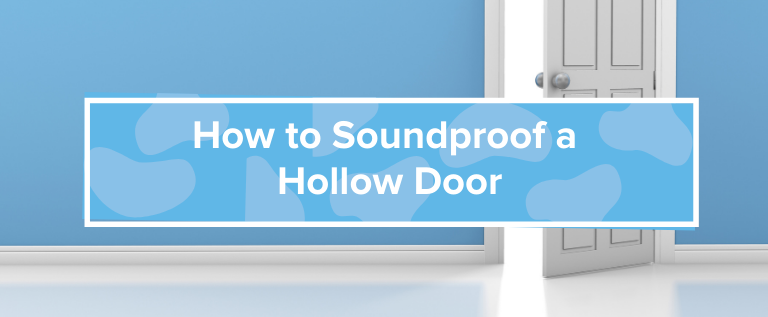
Controlling the flow of noise between rooms in your home makes it quieter and more comfortable. Most soundproofing solutions reduce transmission between walls. However, the solution is only as effective as the weakest link. Your doors are the most vulnerable to noise transmission, which is especially true of hollow-core doors.
Sound travels through the air-filled space in your hollow-core door, letting in noises from the outside. Hollow core doors present acoustic challenges, but there is no need to moo-ve on to a new type of door just yet — the experts at Soundproof Cow know a few effective solutions.
Here, you will learn more about the details of sound transmission, gaining a deeper understanding of why you hear so much sound through your hollow-core door. With this, you will also learn how to soundproof a hollow door to create a quiet, peaceful space.
Table of Contents:
How Sound Travels Through a Door
Methods to Soundproof a Hollow-Core Door
– Increase the Hollow Door’s Mass
– Fill the Space Under the Door
– Drape a Soundproof Blanket Over the Door
– Hang Soundproof Curtains Over the Door
How Sound Travels Through a Door
The air around you holds trillions of spaced molecules. Sound is an energy-filled vibration that travels through these molecules, gradually losing energy when passing through each one. Sounds travel through solids, too, which consist of much more densely packed molecules.
Sounds reach your door in waves. When sound waves hit the surface, some of the energy-filled vibrations travel into it, bouncing through molecules and eventually reaching the other side of the door — unless there is something to absorb or deflect the excess sounds. Some sound waves bounce off of surfaces, too, known as reverberation.
Hollow-core doors have three layers — two thin veneer or panel exteriors and an air-filled honeycomb interior. Because there is little solid space to travel through, sound easily transfers through those layers. But you do not have to invest hundreds of dollars in a solid wood or solid-core door. Rather, consider investing in soundproofing methods.
When attempting to soundproof hollow doors, you want to control two types of sounds:
- Airborne noises pass through air, like people talking or the sound of a TV in an adjacent room.
- Structural noises pass through solids, like someone walking down the hallway or knocking on the door.
Keep in mind you can soundproof a hollow door, but you will not block out every noise. There are methods you can use to absorb reverberated sounds and excess airborne or impact noises.
Shop Door soundproofing Materials
Types of Doors to Consider
Some doors are more prone to excess sounds than others. In your home, you likely have one of three options:
- Solid wood is an all-wood door commonly used for interior and exterior purposes.
- Solid-core is a wooden-core door, sometimes with an external wooden veneer used for interiors.
- Hollow-core is primarily a veneer door with an air-filled core used for interiors.
Remember, solids have more molecules for sounds to pass through, which means more energy is exerted, resulting in a shorter sound lifespan. So, doors with more solids are better at soundproofing than those with more air. Still, you can add soundproofing materials to a hollow door to help minimize sound.
What Is Inside a Hollow-Core Door?
If you split a hollow-core door in half vertically, you will see three layers, which include two exterior paneling or veneer layers and one interior honeycomb-patterned cardboard layer. A wooden frame connects these three layers.
The honeycomb-patterned cardboard sections make hollow-core doors more affordable and lighter to apply. But it is air-filled, making it more prone to noise transfer than other wooden or solid-core doors.
How Can You Tell Your Door Is Hollow?
One way you can tell your door is hollow is by knocking on it. If you compare the sounds from knocking on a solid-core and hollow-core door, you will notice that hollow-core doors sound noticeably hollow — as you might have guessed. But some hollow-core doors won’t always sound hollow. For these scenarios, look for other telltale signs, like if your door is veneer or lightweight.
Are Solid Doors More Soundproof?
Compared to hollow-core doors, solid doors are more soundproof. The honeycomb-patterned cardboard interior lowers the door’s density compared to solid doors, so sound travels through more easily. Additionally, the veneer or paneling exterior layers are comparatively thinner than solid wood doors, making it easier for sound waves to pass through.
Are Hollow-Core Doors Good?
Just because solid doors are more soundproof than hollow-core doors does not mean one option is definitively better than the other. Hollow-core doors still have their unique benefits — they are less expensive and easier to carry and install than solid doors. Plus, there are ways you can improve your hollow-core doors to have the best of both worlds.
Can You Fill a Hollow Door With Foam?
You can fill a hollow door with foam, but it requires time and some advanced installation techniques. Your best option is to invest in one or more other soundproofing options.
How to Soundproof a Hollow-Core Door
Follow these steps to maximize your hollow-core door’s soundproofing performance.
1. Increase the Hollow Door’s Mass
Adding mass to your door is option number one. With more mass, a soundwave will expend more energy to vibrate the door, which it must do to reach the other side. There are a few options for increasing the door’s mass:
Mass Loaded Vinyl (MLV) Barriers
MLV barriers are vinyl sheets that increase the mass and density of any object. Typically, MLV barriers go on the back of a drywall sheet so they remain inconspicuous. But, the thin Quiet Barrier® MD Soundproofing Material is an effective tool for soundproofing a hollow-core door, too.
Quiet Barrier® MD Soundproofing Material has three layers — an absorbent core barrier for structural vibrations and two external foam layers for reflection resistance. Since they are made of salt, sand and tiny metal particles, these sheets are also environmentally friendly.
Applying MLV to a Hollow-Core Door
Many Quiet Barrier MLV sheets and rolls have adhesive sides for peel-and-place application. For those that do not, you can apply a soundproofing adhesive to hold the material in place. The adhesive works like glue — apply it to the back of the soundproofing material and then press it into the door’s surface.
Acoustic Foam Panels
Acoustic foam panels are sheets of open-cell or closed-cell foam that absorb sound energy. A sound-absorbing product plays a different role than a soundproofing material. They minimize reverberations within a room by capturing sound waves that would otherwise reflect off hard walls, floors and ceilings. Acoustic panels make a noisy room seem quieter.
You can install acoustic panels on the door’s surface for exterior reflection resistance. Some of Soundproof Cow’s reinforced aluminum-facing acoustic foam and Quiet Door™ acoustic panels support peel-and-place application. Simply remove the adhesive covering and press the adhesive end directly onto your door.
Additionally, if you are ready for a more involved DIY project, you can put acoustic foam inside the hollow-core door. This helps to disperse energy that vibrates through the door’s surface and the MLV layers you placed on top. Applying interior foam will require you to remove the door from its hinges, disassemble it, insert the foam and put the door back together.
Quiet Door™ Acoustic Panel
The Quiet Door™ Acoustic Panel is effective and easy to install as a door covering. Its two-part construction comprises a sound-deadening polymer and a fabric-wrapped acoustic panel. The product’s low-profile design blends with the room. You can even decorate it with photos and posters using push pins.
2. Seal the Door Frame
Sound waves easily travel through open air, so the gaps around your door are important to address. Filling the space will prevent noise from squeaking in or out.
Quiet Door™ Perimeter Seal
The Quiet Door™ Perimeter Seal fits around the door to cover gaps along the top and sides with an aluminum and silicone-based blockade. The aluminum baselines the doorframe, and the silicone filling seals the gaps.
Installation requires a drill, Phillips-head screwdriver, tape measure and a hacksaw. Trim some wood off of the door or frame to make space, then screen the aluminum into place. The Quiet Door™ Perimeter Seal adapts to almost any door.
3. Fill the Space Under the Door
The bottom of any door has a gap between it and the floor. You can fill the space under the door using the Quiet Door™ Perimeter Seal’s companion product — the Quiet Door™ Door Sweep.
Quiet Door™ Door Sweep
Place the Quiet Door™ Door Sweep under the door to block noise. It comprises an aluminum base and a silicone seal for performance similar to the Perimeter Seal. This hollow-core door soundproofing tool doubles as a draft stopper, too. The gap under the door is typically the largest, so it allows the most warm air to escape. Filling that gap can stabilize the room’s temperature and reduce your monthly utility bills.
4. Place a Door Rug on Either Side
Sound waves can reflect off of a hard floor and bounce under the door. To minimize these reflections, soften the surface on either side of the door’s base. Installing a wall-to-wall carpet is one solution to consider if you are comfortable covering your original flooring material. If you prefer the look of your hardwood floor, a pair of rugs will work nicely. Carpets and rugs have fibers that can trap and absorb some of an airborne sound wave’s energy. A carpet or rug with a rubberized base can also reduce some structural noise.
You can use any rug for this solution. The most important feature is its size. Use one that spans your doorframe’s entire width.
5. Drape a Soundproofing Blanket Over the Door
Soundproofing blankets are ideal when you need a solution that is more temporary or portable than others that require rigid installation, like art acoustic panels. You can drape a soundproofing blanket over the door when you need it and remove it when you do not. They are ideal for your home office, bedroom, basement and other rooms where you need temporary relief from noise.
Quiet Barrier® Acoustic Quilts
The Quiet Barrier® Acoustic Quilt is an absorbent product you can hang on a door. It has metal grommets that allow you to hang it from wire, string, hooks, chains, nails or screws.
This soundproofing blanket resembles an industrial quilt, but it features a nonporous vinyl fabric that deflects sound. Its soft interior material adds an absorbent element, too, reducing reflections. As a temporary barrier, you can put it up and take it down at any time.
The Quiet Barrier® Acoustic Quilt comes in many sizes, including 2 feet by 4 feet, 4 feet by 4 feet and 4 feet by 8 feet. Overlapping two of the 2-foot by 4-foot models may work best for doors.
Quiet Barrier® Lag Composite
Soundproof Cow’s Quiet Barrier® Lag Composite is a blanket with a 1-inch quilted fiberglass layer for absorption and a 1/8-inch polyester film facing. Quiet Barrier® Fiberglass Composite is a long-term solution. Apply it to your door using a reliable soundproofing adhesive, like the PL® Premium Polyurethane Construction Adhesive. When securing to your door, apply the adhesive to the fiberglass side of the composite.
6. Hang Soundproofing Curtains Over the Door
Soundproofing curtains can dampen and absorb noise. Their thick, dense and porous materials reduce vibrations and reflections alike. A dependable soundproofing curtain should include more than a label boasting its thickness. The ideal product features numerous layers of dense, tightly woven fabric. Choosing a curtain that stretches from the ceiling to the floor will ensure coverage around all gaps.
To install a soundproofing curtain, drill a sturdy curtain rod into the wall above the door and drape the curtain over it. Let the curtain hang on the noisy side of the door. You can also drape the curtain over both sides and close the door for a tight seal.
Your hollow-core door may be playing a huge role in your home’s noise pollution. Sound waves easily travel through air-filled spaces, like across rooms or through your hollow door’s air-filled core. When you want to make rooms in your home quieter, many professional soundproofing tools can help you get the job done.
Meet the Herd — Who Is Soundproof Cow?
When looking for soundproofing tools, trust the herd of professionals at Soundproof Cow. We understand the soundproofing needs of different spaces. Our goal is to make soundproofing easy because you deserve a noise-controlled space that promotes efficiency and comfort.
Soundproof Cow offers a wide range of DIY soundproofing tools to commercial and residential customers. There are tons of projects to consider — your walls, ceilings, interior and exterior doors, windows and other areas. We are here to help you through any of your soundproofing projects. Contact Soundproof Cow for Soundproofing Tools
Contact Soundproof Cow to learn more about our soundproofing options. Reach out to us online or give us a call at 844-864-5389.




